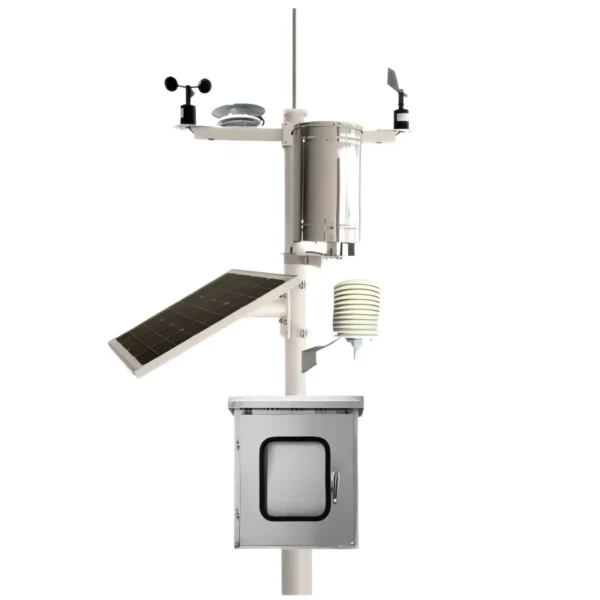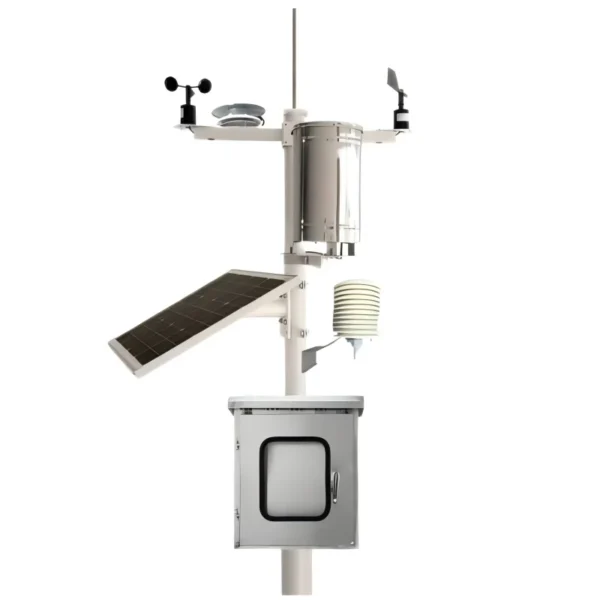
# Automatic Weather Station: A Comprehensive Overview
## Introduction to Automatic Weather Stations
An Automatic Weather Station (AWS) is a sophisticated system designed to collect and record meteorological data without the need for constant human intervention. These stations are equipped with various sensors that measure parameters such as temperature, humidity, wind speed, wind direction, rainfall, and atmospheric pressure. The data collected is then transmitted to a central database for analysis and dissemination.
## Components of an Automatic Weather Station
An AWS typically consists of several key components:
– Sensors: These are the primary data collection tools, each designed to measure a specific meteorological parameter.
– Data Logger: This device records the data collected by the sensors and stores it for later retrieval.
– Power Supply: AWS units are often powered by solar panels or batteries to ensure continuous operation in remote locations.
– Communication System: This allows the station to transmit data to a central server or database, often via satellite, radio, or cellular networks.
– Mounting Structure: The sensors and other components are mounted on a sturdy structure to ensure accurate measurements and protect the equipment from environmental factors.
## Applications of Automatic Weather Stations
Automatic Weather Stations have a wide range of applications across various fields:
– Agriculture: Farmers use AWS data to optimize irrigation schedules, predict frost events, and manage crop health.
– Aviation: Accurate weather data is crucial for flight planning and safety, making AWS indispensable for airports and airlines.
– Disaster Management: Early warning systems rely on AWS to monitor and predict severe weather events such as hurricanes, floods, and droughts.
– Environmental Monitoring: Researchers use AWS to study climate change, track pollution levels, and monitor ecosystems.
– Urban Planning: City planners utilize weather data to design infrastructure that can withstand local climatic conditions.
## Advantages of Automatic Weather Stations
The use of AWS offers several significant advantages:
– Accuracy: Automated systems reduce human error, providing more reliable and precise data.
– Real-Time Data: AWS can transmit data in real-time, allowing for immediate analysis and response.
– Cost-Effectiveness: Once installed, AWS require minimal maintenance and can operate continuously, reducing long-term costs.
– Remote Monitoring: AWS can be deployed in remote or inaccessible locations, providing valuable data where traditional methods are impractical.
– Scalability: Networks of AWS can be expanded to cover larger areas, providing comprehensive weather monitoring.
## Challenges and Considerations
While AWS offer numerous benefits, there are also challenges to consider:
– Initial Investment: The cost of purchasing and installing an AWS can be high, particularly for advanced models.
– Maintenance: Regular maintenance is required to ensure the sensors and other components function correctly.
– Data Management: Handling and analyzing large volumes of data can be complex and resource-intensive.
– Environmental Factors: Extreme weather conditions can damage or disrupt the operation of AWS.
– Calibration: Sensors must be regularly calibrated to maintain accuracy, which can be time-consuming and require specialized knowledge.
## Future Trends in Automatic Weather Stations
The future of AWS is likely to be shaped by several emerging trends:
– Integration with IoT: The Internet of Things (IoT) is enabling AWS to become more interconnected, allowing for more comprehensive data collection and analysis.
– Advanced Sensors: Developments in sensor technology are leading to more accurate and versatile AWS capable of measuring a wider range of parameters.
– Artificial Intelligence: AI and machine learning are being used to enhance data analysis, improving the accuracy of weather predictions and forecasts.
– Miniaturization: Smaller, more compact AWS are being developed, making them easier to deploy in a variety of environments.
– Renewable Energy: The use of renewable energy sources, such as solar power, is becoming more prevalent, reducing the environmental impact of AWS.
## Conclusion
Automatic Weather Stations are invaluable tools for collecting and analyzing meteorological data. Their ability to operate autonomously and provide real-time information makes them essential for a wide range of applications, from agriculture to disaster management. While there are challenges associated with their use, ongoing advancements in technology are likely to enhance their capabilities and reduce
Keyword: automatic weather station
